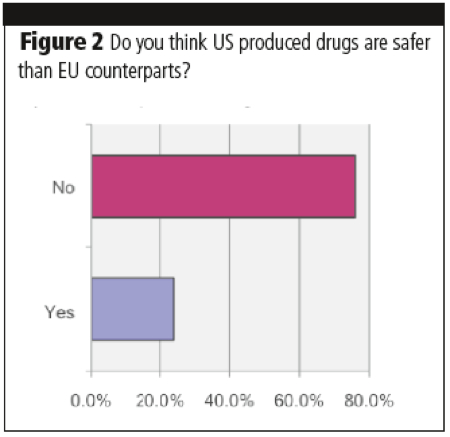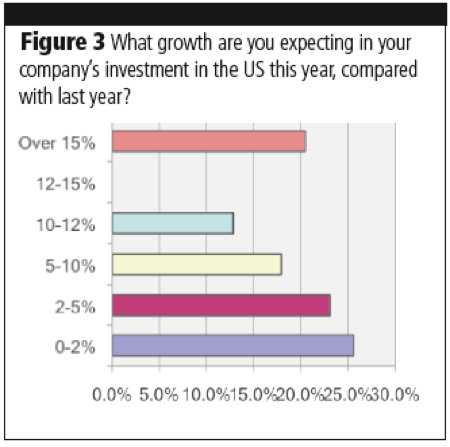The US pharmaceutical market is the largest in the world, projected to be worth nearly US$350bn by 2015, according to IMS Health, and growth among domestic companies looks set to continue. According to a new Pharma Insights report on the US market published as a joint venture by CPhI Worldwide and InformEx, just under half of the domestic companies questioned said they would be increasing their investment spending by at least 10% this year and a quarter by more than 15%.
A further sign of optimism is that 40% of companies said they would be increasing headcount this year. A further 50% had no plans to alter headcount – an indication of stability across the market – while just 8% of respondents are cutting headcount and consolidating. In addition, a quarter of companies asked are planning an international acquisition in the next 1–3 years, with a further 12.5% planning domestic acquisition.
The main area for investment is APIs, cited by 76.2% of respondents. As the West is increasingly being challenged by the Asian pharma market, the results suggest that this could be an effort to better regulate the ingredients supply chain. It is widely accepted that China is a clear leader in the realms of API manufacturing, particularly due to its low cost product offerings, and as noted in previous Pharma Insights reports, few companies are adequately testing ingredients.
Formulation development was the second most important area of investment, although fewer than a third of companies expressed intentions to invest, while finished dosages and packaging followed with 23.8% and 19.05% respectively. Only a fifth of US companies surveyed are investing in generics, which the report said was surprising in view of the height of the patent cliff.
The dramatic restructuring of the US healthcare system is having long term implications
The dramatic restructuring of the US healthcare system is having long term implications. The growth of the domestic market is lagging behind the expansion of the ‘pharmerging’ markets of China, Brazil, India and Russia and cost-effective healthcare is changing in its development and delivery. To continue to prosper, US pharmaceutical companies must adopt innovative business strategies.
The report says that there must be more emphasis on the economic outcome as a determinant in R&D and commercialisation, a shift from blockbuster drugs to personalised medicines, more reliance on external partners for increased production, expansion to pharmerging countries for talent and new markets, and investment in new technology to increase efficiency and drive innovation. ‘The future of the US pharma market will depend on how well companies can adapt to a changing market and the steps they take to sustain their next phase of growth and competitiveness in the global market,’ it says.
But the evidence suggests that recent changes within the pharmaceutical sector are providing more opportunities than threats. US companies are exporting to international markets, notably Canada and Europe, and are successfully showing solid levels of growth and expansion to further position themselves at the forefront of the global pharmaceutical industry.
The US remains under increasing price pressure from overseas generics and is forced to spend more time and money on compliance related issues than its international competitors
But domestic companies seem to be torn between increasing opportunities in the US and global pressures. According to the report, the belief is that ‘good companies will continue to survive’ and that ‘patent issues come into play and force the market to work with domestic CMOs only at times’. However, the US remains under increasing price pressure from overseas generics and ‘is forced to spend more time and money on compliance related issues than its international competitors’.
Recently, more changes have been made to drive the industry to strive for better GMP and higher quality products. Overall, US companies predominantly agreed that FDA regulatory changes are providing their businesses with opportunities (83%), rather than threats (17%). One respondent noted that the FDA moves are good for business as they force the industry to build a culture of continuous improvement. In particular, QbD and a commitment towards continuous improvements have created clear separation ‘between companies that really have quality systems in place and the wannabes’.
Overall, US companies predominantly agreed that FDA regulatory changes are providing their businesses with opportunities (83%), rather than threats
But many of those surveyed believed that the FDA’s lengthy product approval process is a significant hindrance to their businesses. Luciano Calenti, President at ACIC, commented that ‘the FDA is suffocating the industry with regulations – changing them but not improving the rate of approval’. Jost Chemical Company agreed that ‘meeting regulations and keeping costs under control is a major challenge’. It is clear that the USA pharma industry and the FDA must work together to meet each other half way to ensure standards are met and challenges are overcome.
Perhaps surprisingly, the report found that recent regulatory infringements by overseas producers, notably in India, have provided a key opportunity for domestic manufacturers to take an increasing share in the generics market, with more than 70% of respondents believing production will increasingly move back to the US (see Figure 1). Thus, despite the cost implications there is a trend for US-manufactured generics.
But while there may be concerns from American companies – and also among consumers – following the publication of several high-profile articles in the media over product quality in the East, it seems that there are very few concerns about the quality of products coming from the EU, with 76% of those asked confirming their belief that EU-produced drugs are just as safe as those made in the US (see Figure 2).

For companies based outside the US, the pharma economy there continues to represent a huge profit opportunity because of government support for research, rapid approval process and, crucially, a largely uncontrolled pricing market. Although they are poorly represented at present, with only a quarter having a US facility, almost a third of international companies taking part in the survey said they were planning a US acquisition over the coming year and many are planning to increase their investment there: 30% are expecting to up their US investment by more than 10% and just under a quarter by more than 15% (see Figure 3).

However, they are choosing to invest in different areas from domestic companies, with only 30% of international companies investing in APIs as well as finished dosages and generics, and just under 30% in formulation development.
According to the report, the fact that nearly three-quarters of the international companies surveyed do not have manufacturing facilities in the US suggests a desire only to sell in the US, not to manufacture there. It may be the largest pharmaceutical market in the world, but some companies find that the US is ‘too focused on costs rather than quality, only making it more expensive in the end’.
Many international companies without much experience of the FDA and its regulations find it harder to adapt to the stringent regulations. The report found that they are very split as to whether the FDA guidelines are providing opportunities or threats to business, with only 5% more overall saying they are providing opportunities. Many believe that new regulations are providing ‘opportunities for big pharma industry but more threats and burdens for smaller players with less capability for GMP compliances’. To meet the regulations they must ‘allocate additional resources, increasing corporate expenditure and reducing net profits’.
This could be one reason, along with relative size and historical ties, why just under half of the international companies surveyed report that less than 10% of their turnover comes from the US; only 9% said the US accounted for more than 50% of their sales.
Domestic companies are looking to acquire more abroad, suggesting that they are seeking both new markets and cheaper manufacturing sites to increase margins of products they sell in the US
The report concludes that the US pharma market has a bright future, particularly for domestic companies. International companies, particularly smaller enterprises, are less optimistic, although the largely uncontrolled pricing continues to be a huge appeal; drugs sold in the equally well regulated European markets are often a quarter of the price of their counterparts sold in the US. However, the relatively high proportion planning to gain a foothold there through acquisition suggests that market entry in this region is essential to long term survival as the industry consolidates.
Domestic companies, however, are looking to acquire more abroad, suggesting that they are seeking both new markets and cheaper manufacturing sites to increase margins of products they sell in the US, the report says.
Perhaps the greatest area for growth within the US market is generics. US-based companies are buying and entering into alliances with major generics players in pharmerging countries, while a rising concern over the safety of overseas manufactured drugs is allowing generics production to move back into the US. The passing of the Patient Protection and Affordable Care Act (PPACA) will accelerate the trend for reduced profits from patented drugs and an increased reliance on generics.
The key drivers of continuous growth in the US are the technical capabilities, modern production base, pool of talented scientists and an established regulatory and IP environment, the report concludes.




